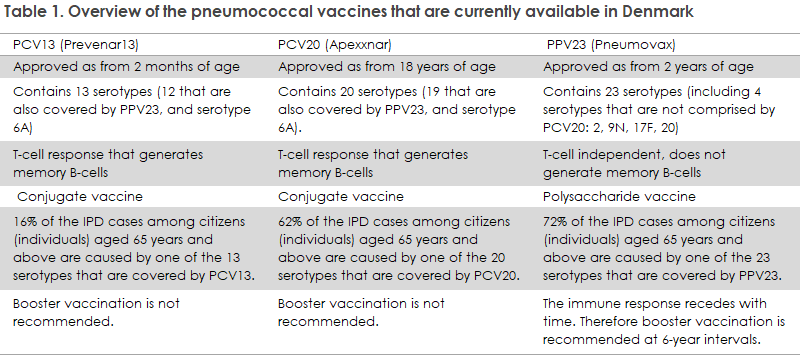No 3 - 2024
Pneumococcal vaccination for people > 18 years who are at especially increased risk of invasive pneumococcal disease
Pneumococcal vaccination for people > 18 years who are at increased and particularly increased risk of invasive pneumococcal disease
Pneumococci are bacteria that may cause a range of infections. Among the more serious infections are pneumonia and invasive pneumococcal disease (IPD), such as meningitis and sepsis. The risk of IPD is highest among children below two years of age and persons aged 65 years and above. For more information about pneumococcal disease, please see here.
Overall, two types of pneumococcal vaccines exist, each with a different mechanism of action: conjugate vaccines and polysaccharide vaccines. The conjugate vaccines produce a prolonged immune response and booster vaccination is not recommended for these vaccines. The immune response of the polysaccharide vaccine recedes with time. Therefore booster vaccination is recommended at 6-year intervals when continuous protection is needed.
Pneumococci are divided into serotypes, of which there are more than 100. No vaccine protects against all serotypes. The conjugate vaccines Prevenar13 (PCV13) and Apexxnar (PCV20) protect against 13 and 20 serotypes, respectively, whereas the polysaccharide vaccine Pneumovax (PPV23) protects against 23 serotypes. The three vaccines are compared in Table 1.

Children are offered pneumococcal vaccination with Prevenar13 as part of the Danish Childhood Vaccination Programme, at 3, 5 and 12 months of age. In addition to the childhood vaccination programme, pneumococcal vaccination may be considered for persons who are at increased and particularly increased risk of IPD. Read more about the risk groups here.
Vaccination proposals depend on the age and vaccination status of the person in question.
The previous offer of free pneumococcal vaccination for individuals aged 65 years and older and persons at an increased risk of IPD is no longer in place, EPI-NEWS no. 51/2022.
Depending on the risk group, the different vaccines may warrant a limited subsidy. For more information about the new subsidy provisions, please see the website of the Danish Health Authority.
Pneumococcal vaccination proposals
Persons < 18 years at increased and particularly increased risk of IPD
In some cases, a child belonging to a risk group may not have received Prevenar13 as part of the childhood vaccination programme and it may be assessed that the child would benefit from this vaccine, possibly in combination with Pneumovax. Information about recommendations for vaccination of children below 18 years of age who are at increased and particularly increased risk of IPD.
Persons ≥ 18 years at increased and particularly increased risk of IPD
Recommendations concerning pneumococcal vaccination for persons aged ≥ 18 years and at increased and particularly increased risk of IPD have changed several times. The current pneumococcal vaccination suggestions for these groups are identical.
The updated suggestions for vaccination are described below and are also available here.
No previous pneumococcal vaccination
Persons aged ≥ 18 years who have not previously received pneumococcal vaccination may be offered vaccination with Apexxnar or Pneumovax. If Apexxnar is used for the vaccination, neither booster vaccination nor subsequent vaccination with Pneumovax is recommended.
Previous Pneumovax vaccination
Persons aged ≥ 18 years who have previously been vaccinated with Pneumovax may either be booster vaccinated with Pneumovax or with Apexxnar. Pneumovax booster vaccination should be administered six years after the latest dose or earlier in the event of suspected reduced immune response. The need for booster vaccination less than six years after the latest dose is assessed following antibody measurement.
If Apexxnar is used for the vaccination, which introduces immunological memory, neither booster vaccination nor subsequent vaccination with Pneumovax is recommended. Vaccination with Apexxnar is given at a minimum one-year interval from the most recent pneumococcal vaccination.
Previous vaccination with Prevenar13 and Pneumovax
Persons aged ≥ 18 years who have previously been vaccinated with Prevenar13 and Pneumovax may be offered booster vaccination with Pneumovax or be vaccinated with Apexxnar.
Pneumovax booster vaccination should be administered six years after the latest dose or earlier in the event of suspected reduced immune response. The need for booster vaccination less than six years after the latest dose is assessed following antibody measurement.
If vaccinated with Apexxnar, neither booster vaccination nor subsequent vaccination with Pneumovax is recommended. Vaccination with Apexxnar is administered at a minimum one-year interval from the most recent pneumococcal vaccination.
Persons at increased and particularly increased risk of IPD who have previously been vaccinated with Pneumovax with no effect on their antibody response
For persons who have previously been vaccinated with Pneumovax repeatedly with no effect on their antibody response, vaccination with Apexxnar may be proposed.
(J. Grau, F. Kristensen Lomholt, Department of Infectious Disease Epidemiology and Prevention)